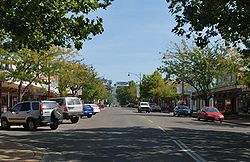Tumut
| Tumut New South Wales | |||||||||
|---|---|---|---|---|---|---|---|---|---|
 Tumut from the top of Wynyard Street | |||||||||
| Coordinates | 35°18′17″S 148°13′22″E / 35.30472°S 148.22278°E | ||||||||
| Population | 6,086 (2011)[1] | ||||||||
| Postcode(s) | 2720 | ||||||||
| Elevation | 305.0 m (1,001 ft) | ||||||||
| Location | |||||||||
| LGA(s) | Tumut Shire | ||||||||
| County | Wynyard | ||||||||
| State electorate(s) | Wagga Wagga | ||||||||
| Federal division(s) | Riverina | ||||||||
| |||||||||
Tumut /ˈtjuːmət/[2] is a town in the Riverina region of New South Wales, Australia, situated on the banks of the Tumut River. Tumut is at the foothills of the Snowy Mountains and is referred to as the gateway to the Snowy Mountains Scheme. Tumut Shire is administered from offices located in the town.
Tumut is approximately 410 kilometres (250 mi) south-west of Sydney and 525 kilometres (330 mi) north-east of Melbourne.[3] [4]
Tumut is home to a number of historic buildings, including an Anglican Church designed by Edmund Blacket and a Courthouse designed by James Barnet. Many of the pubs in the town have been in use from the mid to late 1800s.
Early settlers established a large number of European deciduous trees throughout the area. The stand of Poplars, Elm and Willow, amongst others, create a well renown display of colour over Autumn. Tumut celebrates this with the yearly Festival of the Falling Leaf.
Inhabitants of Tumut refer to themselves as Tumutarians.
Etymology
The word Tumut is derived from the Aboriginal word of doomut or doomat, meaning camping by the river.[5]
History

Tumut Post Office opened 1 January 1849.[6]
Tumut was one of the ten areas short-listed in 1908 as a site for the Australian Capital Territory. Other locations that were short-listed include Albury, Armidale, Bombala, Dalgety, Lake George, Orange, Tooma, Lyndhurst and Yass-Canberra.[7]
Industry
Tumut is the centre of a thriving softwood industry based on plantation Pinus radiata. CarterHoltHarvey Woodproducts (Central and Northern Regions) Pty Ltd operate a major sawmill on Adelong Road (the Snowy Mountains Highway) and a chipboard panel factory next door. 8km further west on the Snowy Mountains Highway at Gilmore the company also operates a sawlog processing plant. The Visy pulp and paper mill is located north of the Snowy Mountains Highway at Gadara (between Tumut and Adelong). The Visy mill is the only paper mill owned by Visy that makes paper from wood (their other mills all use recycled paper as the raw material), and is one of the biggest wood mills in Australia.
References
- ^ Australian Bureau of Statistics (31 October 2012). "Tumut (Urban Centre/Locality)". 2011 Census QuickStats. Retrieved 5 November 2012.
- ^ Macquarie Dictionary, Fourth Edition. Melbourne: The Macquarie Library Pty Ltd. 2005. ISBN 1-876429-14-3.
{{cite web}}: Missing or empty|title=(help); Missing or empty|url=(help) - ^ "Sydney-Tumut". Google Maps. 2008. Retrieved 31 March 2008.
- ^ "Melbourne-Tumut". Google Maps. 2008. Retrieved 31 March 2008.
- ^ Reed, A. W. (1973). Place Names of Australia (paperback). Frenchs Forest, Sydney: Reed Books Pty Limited. p. 214. ISBN 0-589-50128-3.
{{cite book}}:|access-date=requires|url=(help) - ^ Premier Postal History. "Post Office List". Retrieved 11 June 2009.
{{cite web}}: CS1 maint: postscript (link) - ^ BBC Canberra, Australian Capital Territory, Australia UPDATE

